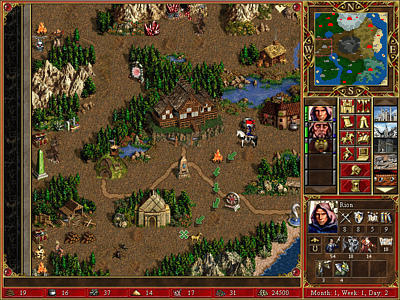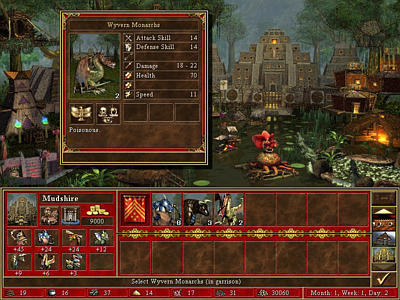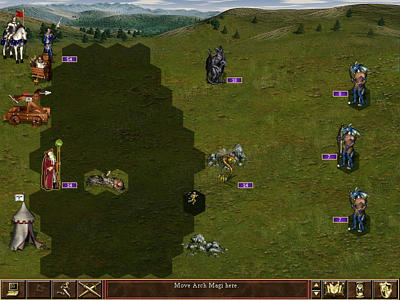
A game whose addictive properties can, quite literally, suck you in until your mouse-hand is spasming involuntarily and your eyeballs are glazed and crusty.
Manufacturer: Loki Entertainment Software
E-Mail: sales@lokigames.com
Price: $29.95 US
Reviewer: J. Neil Doane
It used to be that turn-based games were all the rage, but somehow it seems that in a world filled with first-person shooters and real-time strategy games, they've fallen through the cracks of general popularity. Loki's Linux port of 3DO's Heroes of Might and Magic III: The Restoration of Erathia sets about to fix that little oversight with a vengeance in a game whose addictive properties can, quite literally, suck you in until your mouse-hand is spasming involuntarily and your eyeballs are glazed and crusty. I mean it, if you believe you might have an addictive personality, if you have someone in your household who might actually want to speak with you in the next few days, if you don't believe your boss will accept, “...can't talk now...game...” as a valid sick-day excuse, think twice before sitting down to a Heroes III session. Fact is, it's the turn-based nature of the game, the part of Heroes III that seems so benign on the surface compared to its faster-paced cousins, that erodes your conscious mind and turns it into a soft, pliable sludge. You begin thinking in terms of how you only need a few more turns to set yourself up for a another small battlefield victory or strategic advantage that leads to a new perspective, a new strategy, which leads you to believe that only a few more turns are needed to set yourself up for something else; and so the vicious circle sucks you in as you hurl yourself onward toward conquest (or sleep deprivation-induced insanity). Heroes III is a game of strategy, chance, tactics and luck; a mixture of some of the best elements from Dungeons and Dragons, Chess, SimCity and Warcraft blended seamlessly into an RPG that makes you the leader of armies of mortals and supernatural creatures fighting against warlocks, wizards, warriors and witches (and worse).
Heroes of Might and Magic III is the latest installment in the epic Might and Magic universe of games and takes up where Heroes II, the ninth title in the saga, leaves off. This time you are on the continent of Erathia where a complicated tale of murder and conquest unfolds as Catherine Ironfist seeks to investigate the death of her father and restore Erathia to its former glory. The story naturally unfolds through movies and cut-scenes with narratives that explain each new situation in a compelling and easy-to-follow format.
Basically, the idea is you control a cadre of “heroes”, the game's main characters, as well as the settlements they conquer, the resources they appropriate, the lands they explore, the armies they command and the treasures they find. Your heroes' goals are typically stereotypical D&D-style objectives (“kill the golden dragon queen” or “find the grail before your enemies do”), and as they progress and mature, they gain experience, new powers, skills, knowledge and new warriors to take into battle. The scope of the game is nothing short of Homeric at times; although you can choose to engage in shorter single-player games if you wish, often even medium-sized quests will last well into the small hours if you aren't careful and in campaign mode. Your characters can grow and mature through a long series of goal-oriented games to reach a final objective that may take many days and nights to complete.

Figure 1. Exploring the Kingdom
As stated before, Heroes III is turn-based; more specifically, each turn lasts for one Erathian day. One day in which you are allowed to control each of your heroes in any way they can be controlled (fighting, moving, teaching, learning, exploring, acquiring resources, trading resources, etc.); and manipulate the activities in the cities under your control (build new buildings, recruit new warriors or heroes, buy or sell merchandise or artifacts, etc.). When you're done with your day's activities, you complete your turn, wait for your opponents to complete their daily events (computer opponents take only moments to make their moves) and then begin the next day's events. Warrior resources in each city are replenished once per week, so if you go out and lose most of your troops in a battle on Monday, you'd better hope you can hold off your attackers for a week with what you have left.
If you think the game sounds complicated, you're right, it is. The learning curve is pretty steep and an intimate look at every detail of the game requires a rather serious study of the included 133-page manual. However, a 12-page PDF tutorial guide is included on the CD, and the built-in tutorial mission takes only about 45 minutes to complete. Afterward, one should have a very solid command of the fundamental game options available and a firm enough handle on the game's mechanics to jump into play and learn the specifics. In fact, for all its complexity, the game interface is intuitive enough that many players will likely find they can head right into the tutorial game and learn enough in a few minutes of poking around at the assorted controls to get themselves on the right track and playing single-player games with relative ease. What's more, the developers took into account the complexity of the game and scattered contextual help liberally. Right-clicking on virtually any place in the game will produce a pop-up window describing in succinct detail the area, button or icon currently under the pointer.
Game play focuses exclusively on the actions of the heroes themselves and the cities under your control. Heroes are responsible for exploring the areas around the cities, locating any of the nearly 130 different artifacts available, finding resources like mines or other sources of income for the city, as well as battling to defend the cities from attack, conquering new cities and fighting other heroes to expand your holdings. Cities produce gold currency from resources you provide them, which you then use to buy buildings and recruit heroes and warriors. Warriors provide valuable services to your heroes and act as a clearing house for all manner of soldiers or creatures your heroes may need in order to beef up their armies.

Figure 2. An Early Fortress Town
The cities themselves come in eight different varieties and are made up of dozens of individual structures, each customized for the type of cities they are built in. For example, in the “Castle” city-type, one will find buildings such as a guardhouse (where pikemen can be recruited), a monastery, training grounds (the favorite hangout of cavaliers) and even supernatural structures like a holy “Portal of Glory”, where one can recruit powerful Archangels for the right price. The flip side would perhaps be the “Inferno” city-type, where such sinister structures as fire lakes can be built to supply supernatural Efreet, kennels built to supply Hell Hounds and the deadly Cerberus, and even a “Forsaken Palace” from which Archdevils are called into the service of your army. Other cities are homes to wizards and genies, Pegasus and dwarves, even dragons and ogres. In total, there are 118 different varieties of creatures at your disposal, and each has specific attack characteristics and features designed to facilitate various tactical roles on the battlefield, from ranged attacks at a distance to close-quarters hand-to-hand combat or anything in between. Each building has a specific cost associated with its construction and some characters and buildings can be used to supply materials or resources. For example, blacksmiths can forge weapons; libraries can enhance the knowledge of visiting heroes; mage towers can be used to teach visiting heroes new spells and incantations; and new heroes can always be found loitering in the local taverns, waiting to be hired to command armies for your kingdom.
There are 128 different individual heroes, each with his or her own unique traits, strengths and weaknesses. These heroes lead your military might, exploring the lands with the armies you've placed under their control, claiming resources for your kingdom and protecting your sovereign territories from hostile invaders. Heroes themselves do not participate in battles, but each has various types of spells, knowledge and skills they can use to drastically help the troops under their command. When in battle, a turn-based combat begins and a close-up view of the hexagonal-grid battlefield is presented, as shown in Figure 3.

Figure 3. Combat Screen
Each side takes turns in combat until a victor is determined, by either one hero vanquishing another's armies through total destruction or by one side surrendering or retreating. In the case of a surrender, the hero runs away in shame, and you'll have to recruit him or her again to get them back into the service of your army. In the case of a defeat or a retreat, the shame is simply too great, and the hero will abandon your cause altogether. Victors of combat receive experience points that will help them gain new levels of maturity and learn new knowledge and skills that can help them in battle or in exploration: skill in tactics can give you free moves at the beginning of combat, skills in navigation can help you move farther each turn while in a ship, skills in diplomacy will help your heroes convince others they meet to join their armies and so on. Combat against fortified cities takes place in a special siege-combat screen, where an attacking hero's army has to bombard and destroy a city's ramparts with catapults in order to physically invade.
The graphics in Heroes III are superbly detailed, colorful and complex. The various interfaces are intuitive and ergonomic, which is fortunate since players will be sitting spellbound and using them for significant fractions of their waking moments. The sound effects and background music are where Heroes III really excels; the music actually changes to fit the mood of the game and does it often, at all the right moments. Exploring your kingdoms, you'll hear classical symphonies and powerful soaring adventure music; go into battle and the score changes to something more foreboding and suspenseful. Head into a castle city and the music is an Arthurian harpsichord concerto; head into a dungeon and the music is an eerie melody with deep oboes and cathedral bells—you get the idea. The music adds much to the ambience of the game and never seems to get old or repetitive.
Multiplayer modes are, historically, one of the best parts of turn-based games and Heroes III's multiplayer action is, unfortunately, still back somewhere in history. While TCP/IP modes of play are available, no functionality exists for connecting to any type of centralized, on-line community to manage multiplayer games. You will need to find the IP address for your Heroes III game host with some other method, and then connect directly to it. Alternately, you can play “hot seat” games, wherein one person sits in the hot seat and makes their moves, gets up and lets the next person play. There is no option to play by e-mail, like a lot of turn-based titles, so to play in that fashion requires players to exchange hot seat files (saved hot seat games) with each other in order to remotely do turn-based, long-term gaming. In this reviewer's opinion, this is really one of the only bad points about Heroes III, and an area that was sorely overlooked by 3DO.
Tested on a Matrox G400-based, 500MHz PIII system with 128MB RAM, this game performed flawlessly. I suspect that it would function quite well on a much lesser system as there is no requirement for 3-D acceleration, and the calculations for combat and movement really shouldn't be that complicated. Loki's recommended minimums for the game are 32MB RAM and a Pentium 133. You'll need an OSS-compatible sound card, as well as an X server capable of doing 800 x 600 in 16-bit color. The install footprint is highly customizable since the installer allows you to separate out all the major components and leave in any of the scenarios, sounds, graphics, music or videos on the CD if you like. This allows Heroes III to take up as little as 5MB to as much as 350MB of your drive's real estate. Depending on how much data you leave on the CD, you may need more than the recommended minimum 4X CD-ROM drive; running the videos from such a slow drive might cause some rather nasty stuttering/rebuffering. As usual, Loki recommends at least any of the 2.2 kernels or above for their game ports.
There are some small problems with the default install. For instance, the version of Heroes III that Loki ships doesn't do full-screen mode by default (or at all as any user other than root from what I could tell). However, Loki's single upgrade patch is only about 1MB and fixes many small bugs, including the full-screen mode problem, and is highly recommended to be applied over the default install before playing. Interestingly, this patch also includes hooks to AAlib, the ASCII Art Library, which supposedly allows truly desperate Heroes III players without X to get their fix from the console in glorious ASCII detail. Additionally, Loki is also offering a beta version of their Heroes III map editor for Linux, which allows you to create your own Heroes III adventures. They are also offering a free 17MB demo of the game from their web site, http://www.lokigames.com/.
Plain and simple, this game is exquisite: turn-based gaming at its finest. The interface makes sense, even if you've never played an RPG-type game before, and the quality of the workmanship, attention to detail and overall polished feel of the game makes everything seem to work the first time, the right way. Although the game is rather complex, it's straightforward and more importantly, fun to learn. Heroes III is one of those games that you sit down to tinker with and end up leaving your desk eight hours later because you have to go to bed sometime. Highly recommended for penguins of all ages.